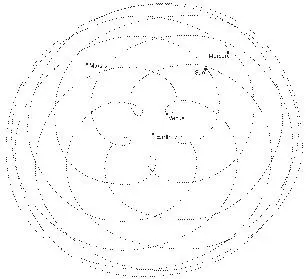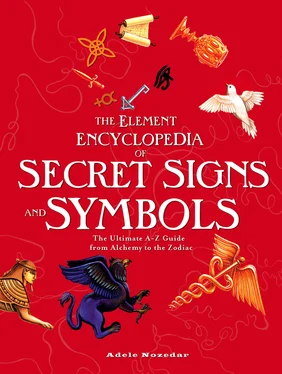Part Three Flora
Part Four Flowers of the Underworld
Part Five Sacred Geometry and Places of Pilgrimage
Part Six Numbers
Part Seven Sacred Sounds, Secret Signs
Part Eight The Body as a Sacred Map
Part Nine Rites and Rituals, Customs and Observances
Part Ten The Nature of the Divine
About the Publisher
INTRODUCTION Part Two Fauna Part Three Flora Part Four Flowers of the Underworld Part Five Sacred Geometry and Places of Pilgrimage Part Six Numbers Part Seven Sacred Sounds, Secret Signs Part Eight The Body as a Sacred Map Part Nine Rites and Rituals, Customs and Observances Part Ten The Nature of the Divine About the Publisher
The aim of this book is to seek a true understanding of the secret signs, sacred symbols, and other indicators of the arcane, hidden world that are so thickly clustered around us. During this process, we’ll shed light on the cultural, psychological, and anthropological nature of our signs and symbols. We’ll also be surprised to discover that many of the everyday things we take for granted can hold hidden secrets, and by having the key to this knowledge we’ll gain an insight into the minds and concerns of our forbears who constructed these symbols.
NO BEGINNING, NO END: ANATOMY OF A SIMPLE SYMBOL
Rodin said, “Man never invented anything new, only discovered things.” While it’s true to say that some symbols have been man-made for a specific purpose, it’s equally accurate to argue that everything is inspired in some way by the natural world around us, by the forms of nature, plants, animals, the elements. Even a reaction against the fluid forms of nature is generally inspired by a desire to provide an alternative. Sometimes the revelation of a natural symbol is immediate; other such discoveries are the result of years of painstaking observation.

One of our simplest symbols has elaborate and arcane origins.
Here is a picture, not of a manmade or computer-generated pattern, but of the shape made in the sky by the Planet Venus. Venus is the only planet whose dance around the Sun in the depths of space describes such a definite and distinctive form, and we can only imagine the sense of wonder that must have been felt by the ancient Akkadians who first charted the design. They also realized that the Morning Star and the Evening Star, previously considered to be two separate celestial bodies, were one and the same. This discovery had a profound effect, which has cast such a long shadow over the archeology of symbols that we are still governed by it today. Here’s why.
Because of Venus’s proximity to the Sun, its light is often obliterated, and so it is visible only in the early morning or in the evening, either just before sunrise or just after sun-set. The Greeks called the morning star Eosphoros, “bringer of the dawn” (later, the star would be called Lucifer, the brightest of the angels cast out of the Heavens). As the Evening Star, it was called Hesperos, “star of the evening” (which gives us the name of evening prayers, or vespers).
It takes eight years and one day for the appearances of Venus to complete an entire pentagram. These days we can plot these movements relatively easily, but for our ancestors the process must have been elaborate and painstaking, as uncertain and laborious a voyage of discovery as the traversing of any great physical ocean. The Goddess that we know as Venus was, to the Akkadians, Ishtar/Inanna, divinity not only of love and harmony but also Goddess of war. Incidentally, Venus is the only major planet of our solar system, aside from the Earth itself, to be designated a feminine spirit.
The Mayans determined their calendrical system from the movements of Venus, and chose propitious positions of the planet to determine the time of a war. The five-pointed star that is still used as a military symbol—stenciled onto tanks, for example, or used in insignia—derives from the stately movement of this great astral Goddess.
Similarly, the apple given by Eve to Adam contained a hidden symbol within it; the pentagram created by the pattern of the pips. Eve offered Adam not only knowledge of the divine feminine—a holy grail indeed—but offered him a symbol of the true marriage of opposites, the feminine number two wedding to the masculine number three. Eve, therefore, personifies Ishtar/Venus/Aphrodite as the Goddess of sensual love (and Venus, incidentally, is the derivation of the word “venereal”). Further, Ishtar was demonized in the Bible as the Whore of Babylon.
So, a seemingly simple thing such as the shape made in the sky by the path of a planet can be full of complexities and contradictions, which not only clarifies some aspects of the symbol but also poses further questions. The truth is that the quest to understand the meaning of a symbol is as much a personal voyage of discovery as a collective one, and it is in the spirit of exploration that I hope you will adventure into this book.
There are several people without whom this book would never have been written. I’d like to thank Katy Carrington, Terence Caven, Jeannine Dillon, Chris Wold, Simon Gerratt, Graham Holmes, Kate Latham, Faith Booker, and Laura Summers at HarperCollins. Charlotte Ridings, Martin Noble, and Mark Bolland were the editors. I’d also like to thank Wanda Whiteley.
Any book about symbols would be nothing without the illustrations. Paul Khera has done the bulk of these, with additional thanks to Anat Cederbaum, Myong Hwi Kim, Kruti Sanaija, and Yuki Nakamura for advice and help with some aspects of these pictures. I am also lucky enough to have Finlay Cowan contribute images to this book.
Other illustrators include David Little, Lyndall Fernie, and Kalavathi Devi. I would also like to thank Willa and Milo Seary for their drawings. Thanks are also due to Gavin and Davina Hogg, Sigorour Atlason, Caroline Danby, Tania Ahsan, Hamraz Ahsan, Carla Edgley, Judy Roland, Theo Chalmers, the Order of Bards, Ovates and Druids, Stuart Mitchell, and the good people of Raquetty Lodge, Hay on Wye. Most of all I have to thank starship commander Adam Fuest for putting up with my obsession about this book and my possible bouts of absent mindedness about anything else during the writing of it.
FIRST SIGNS: THE BASIC SHAPES OF SYMBOLS
There are certain elemental structures that occur repeatedly, not only as component parts of more elaborate symbols, but also with rich meanings of their own. In fact, it’s probably true to say that the simpler the symbol, the more scope there is for interpretation; ergo, the more meaningful it is and, paradoxically, the more complex it becomes. These primary shapes transcend barriers of time, geography, and cultural context, part of a universal language that goes before, and beyond, words. Don’t be fooled into thinking that these basic shapes are as self-explanatory as to need no analysis. A true understanding of what they represent can only add to the comprehension of the more elaborate shapes and symbols that follow in this section.
The elements of a symbol are defined only by the space that is a part of its construction. Like the wind, the effect of space is gauged by its effect on the things within it or surrounding it. The concept of space, the void, is a profound part of our experience. To reach a state of “emptiness” is, for many, the ultimate spiritual experience and a way of connecting to the Absolute. When John Lennon wrote “Imagine,” whose lyrics gradually strip away the trappings of the material world, it was this idea that inspired him.
Читать дальше













